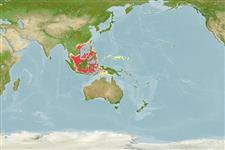Common names from other countries
Classification / Names / Names
Common names | Synonyms | Catalog of Fishes (gen., sp.) | ITIS | CoL | WoRMS
Environment: milieu / climate zone / depth range / distribution range
Ecology
Pelagic. Tropical; 25°N - 8°S, 71°E - 126°E
Indo-West Pacific.
Length at first maturity / Size / Weight / Age
Maturity: Lm ? range ? - ? cm Max length : 0.6 cm BL male/unsexed; (Ref. 3682)
Rare species (Ref. 81541). Chaetognaths are carnivores, feeding mostly on copepods, crustacean larvae and other chaetognaths, and also occasionally on forams and fish larvae (Ref. 81541). Mean latitude of occurrence = 8.25 (N); Present in China (Ref. 125708).
Life cycle and mating behavior
Maturity | Reproduction | Spawning | Eggs | Fecundity | Larvae
Members of the phylum Chaetognatha are hermaphroditic. Mating behavior: A preliminary visual signaling behavior for species recognition is observed to prevent predation. Life cycle: Eggs directly develop into miniature adults (hatchlings).
Pierrot-Bultz, A. 2004. (Ref. 3682)
IUCN Red List Status (Ref. 130435)
CITES status (Ref. 108899)
Not Evaluated
Not Evaluated
Human uses
| FishSource |
Tools
More information
Age/SizeGrowthLength-weightLength-lengthMorphologyLarvaeAbundance
Internet sources
Estimates based on models
Vulnerability
Low vulnerability (10 of 100).
Price category
Unknown.
